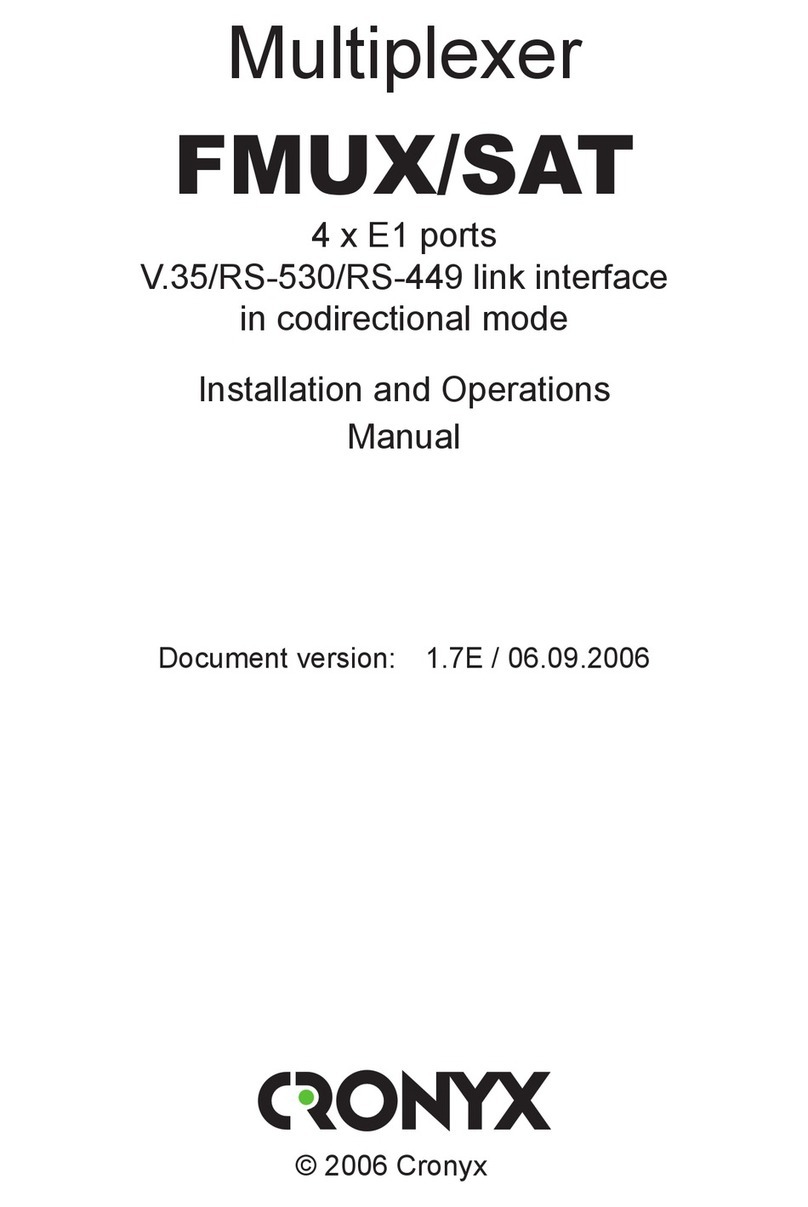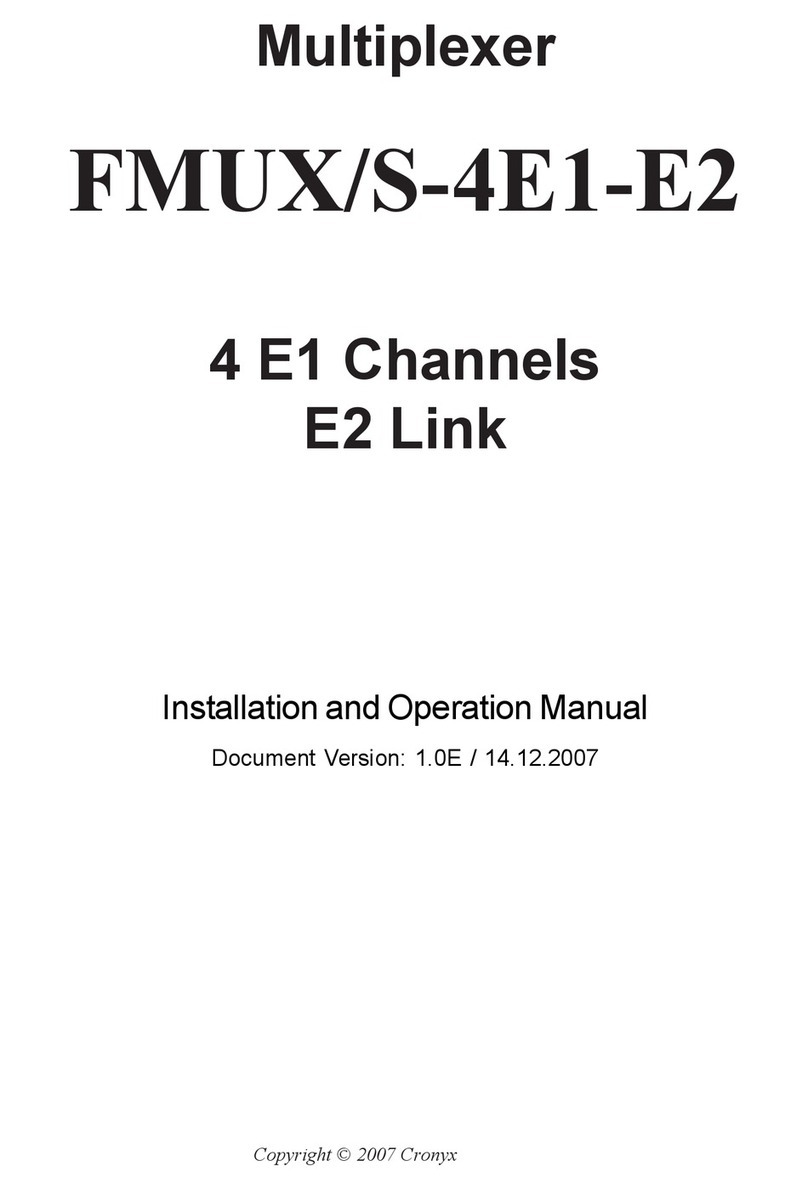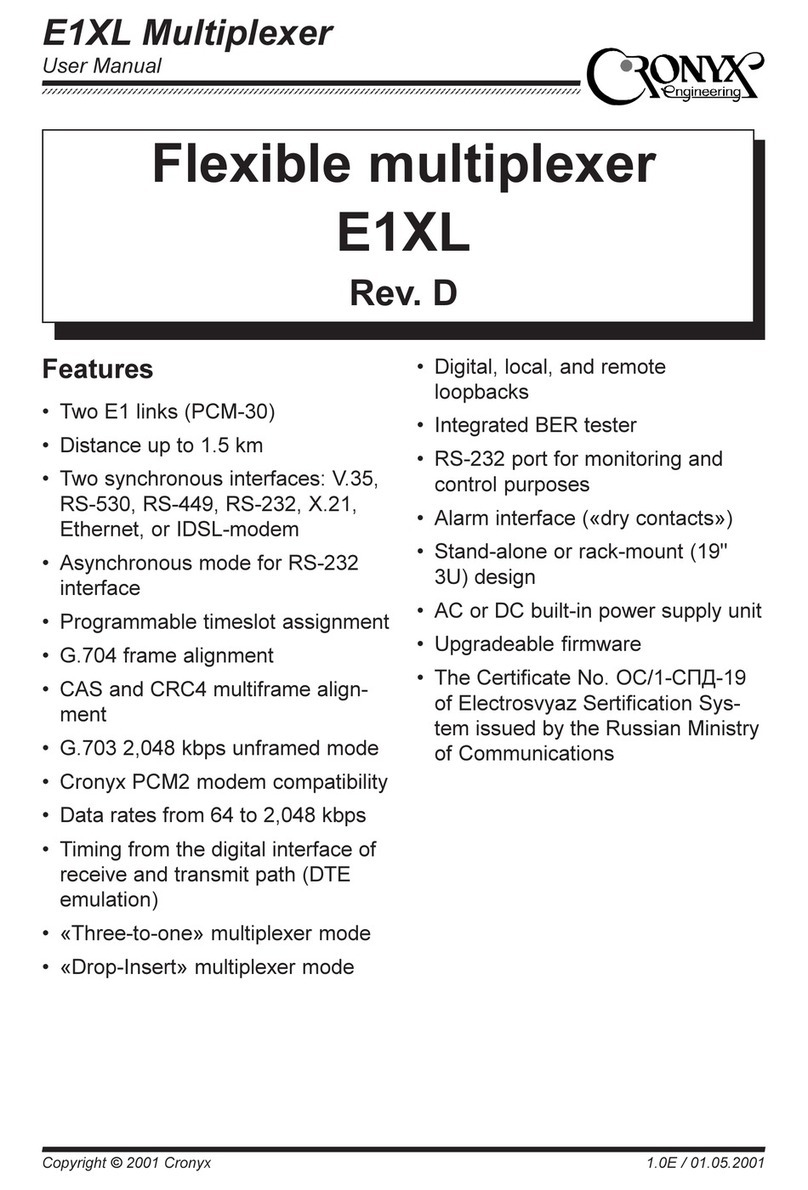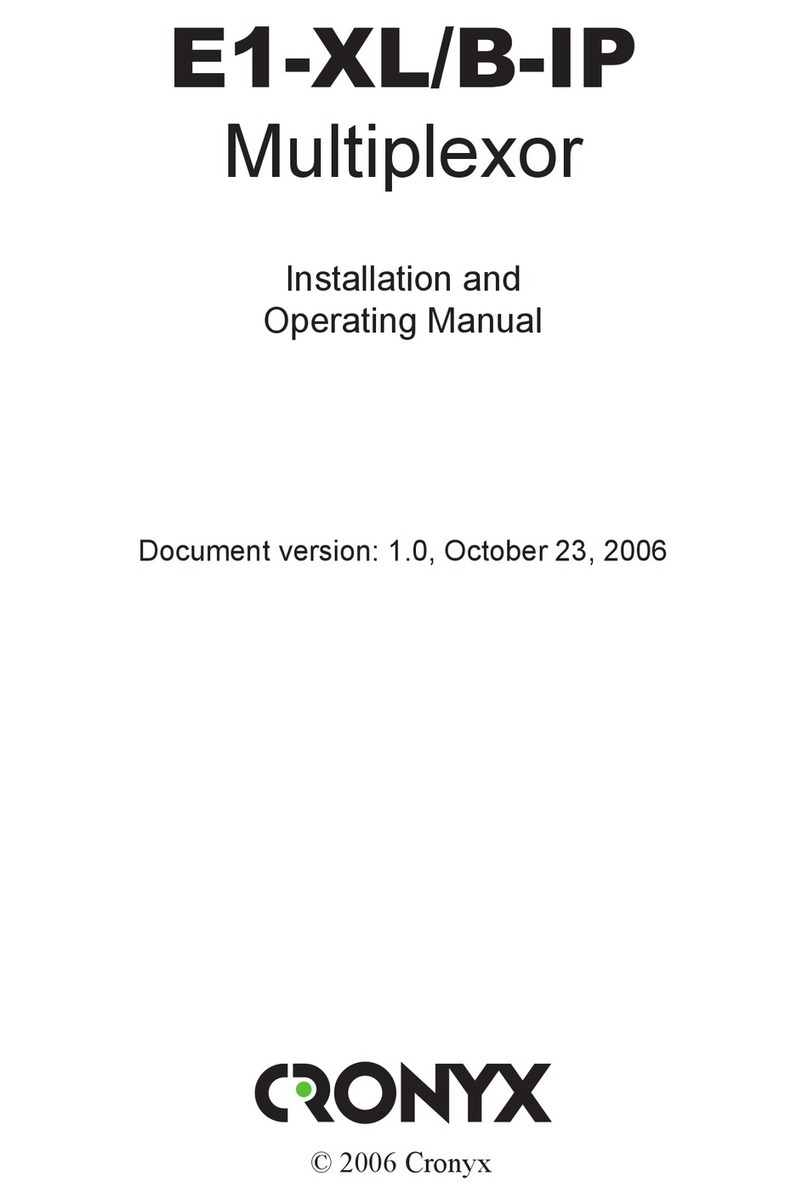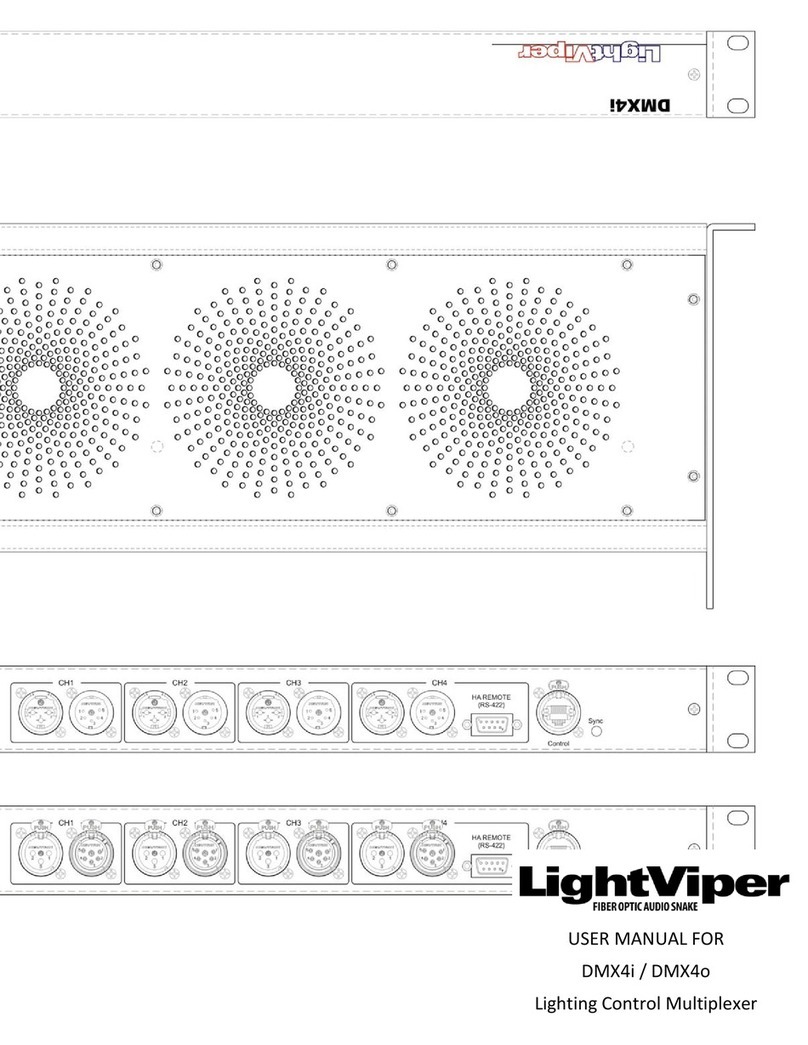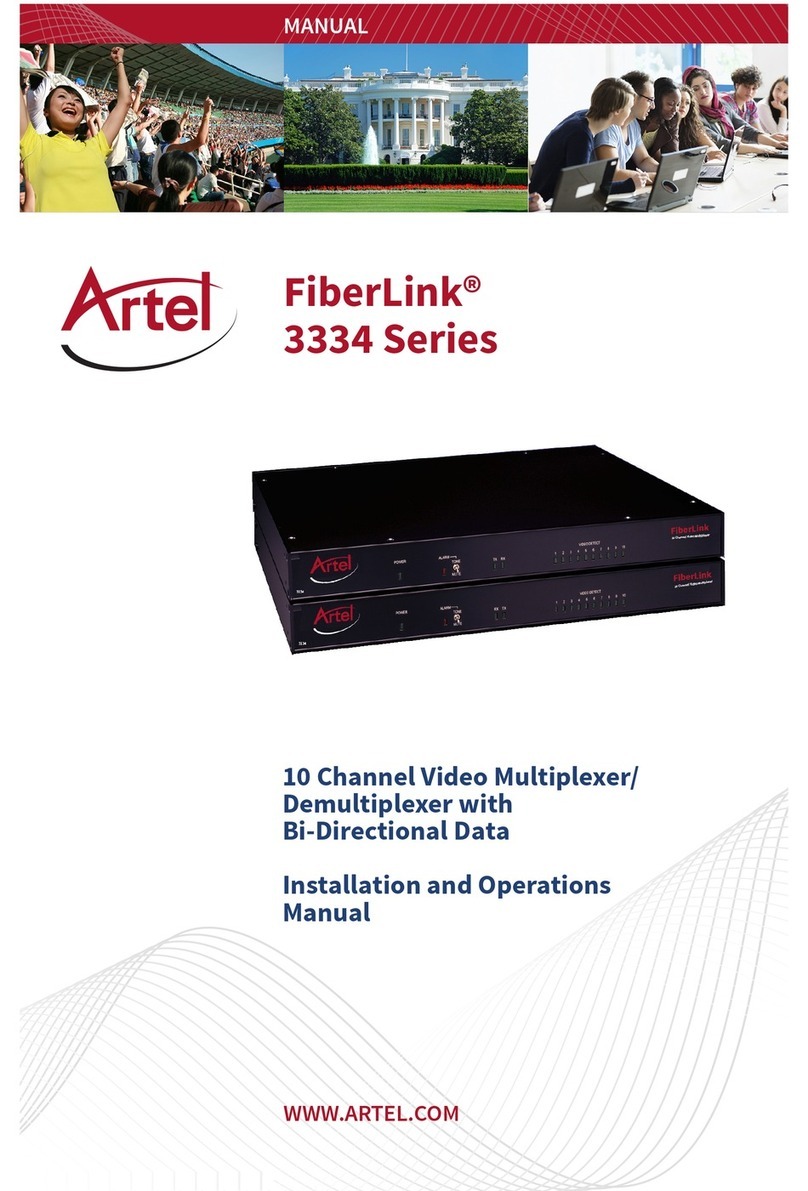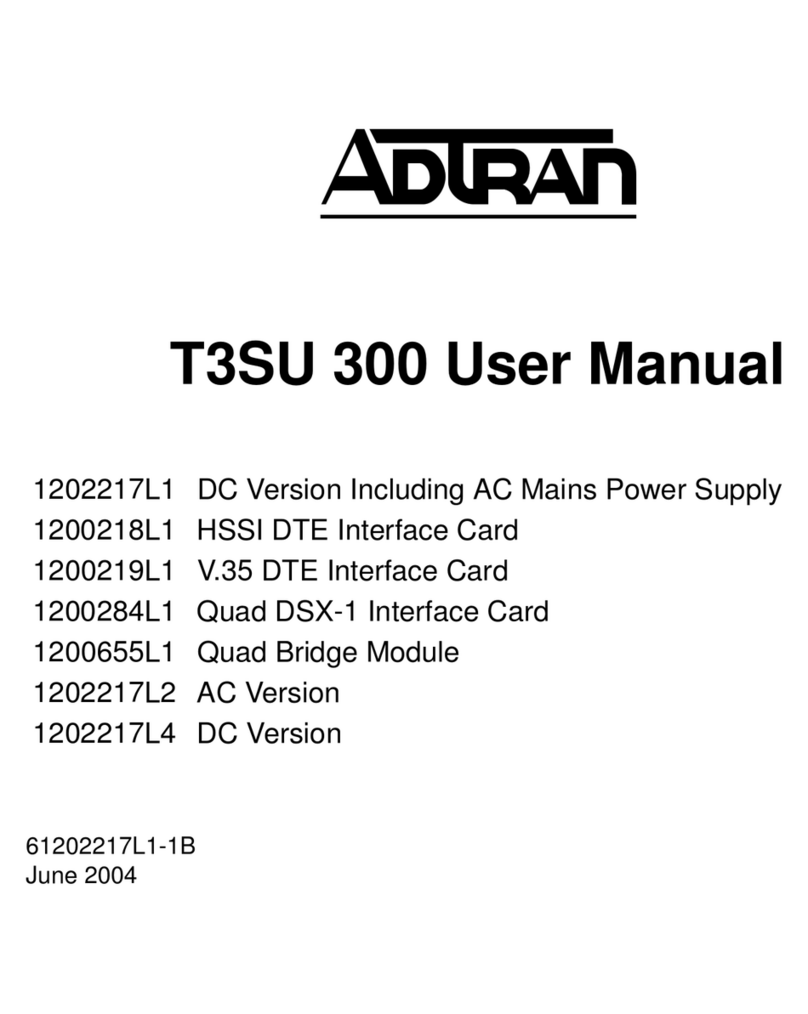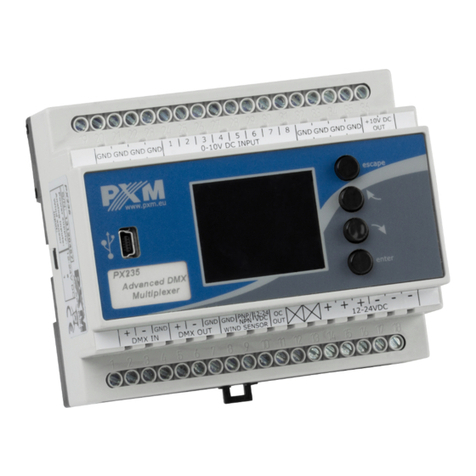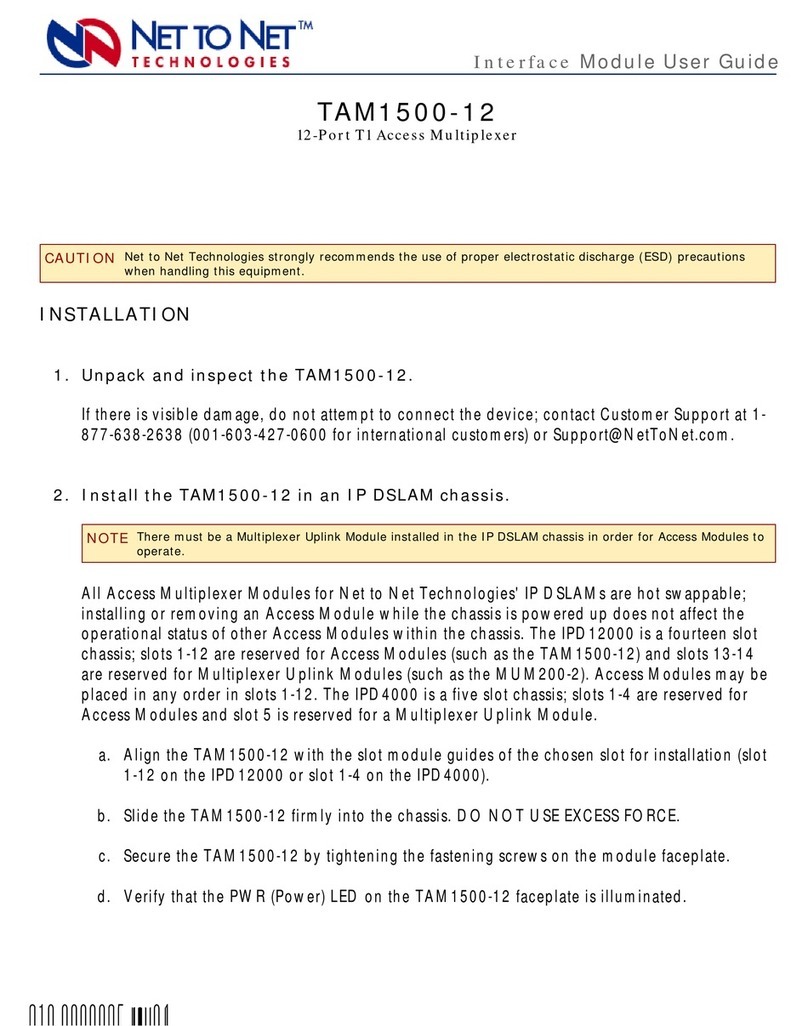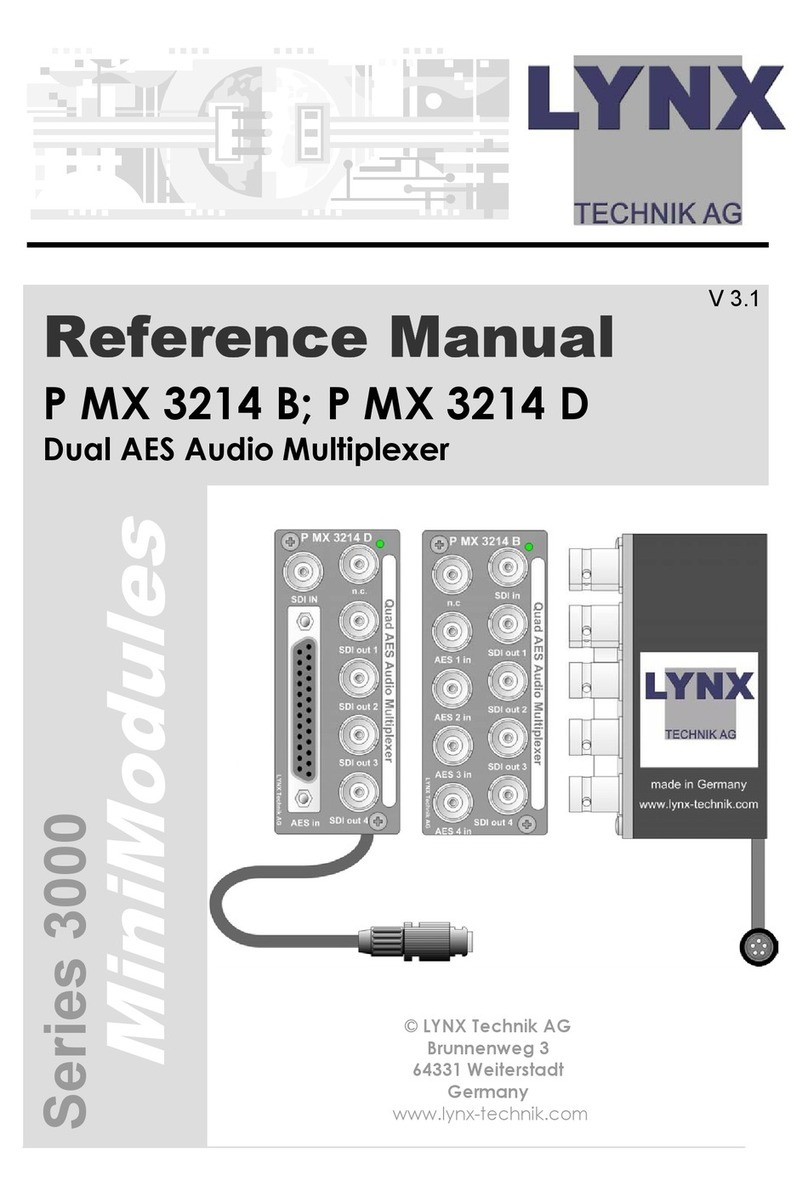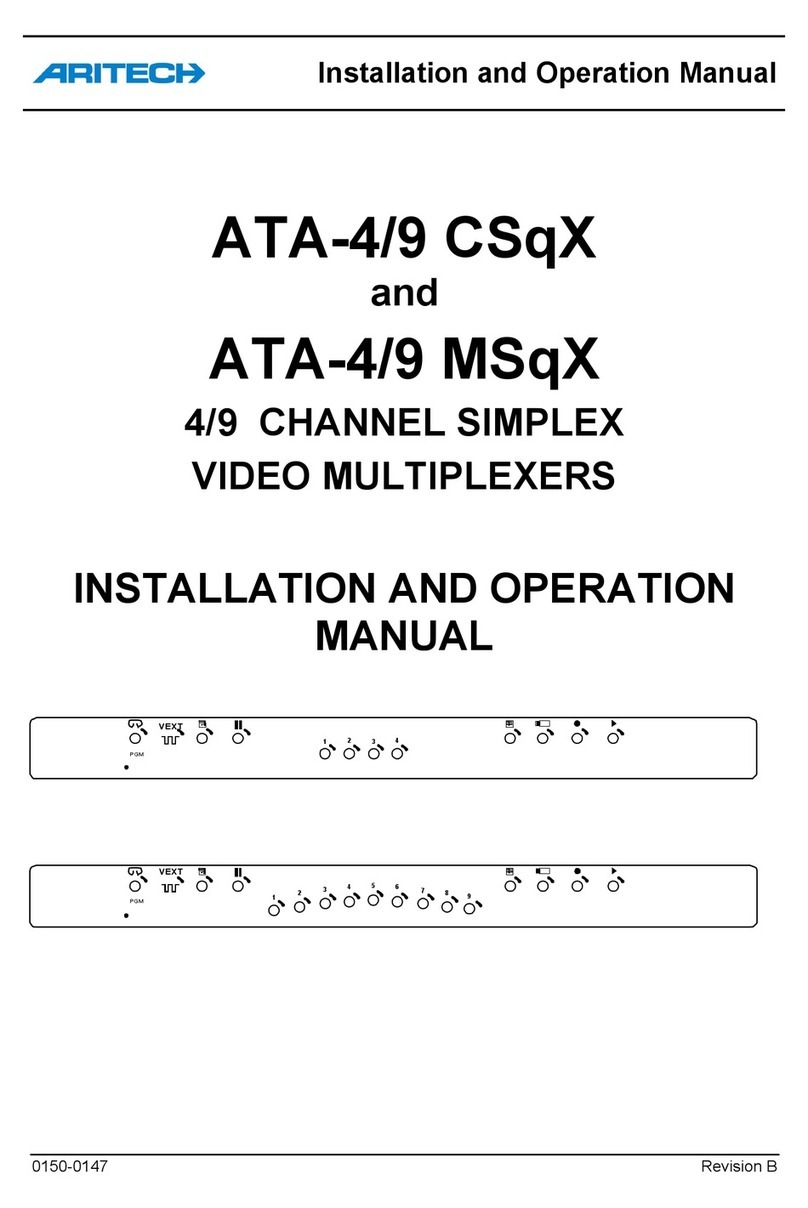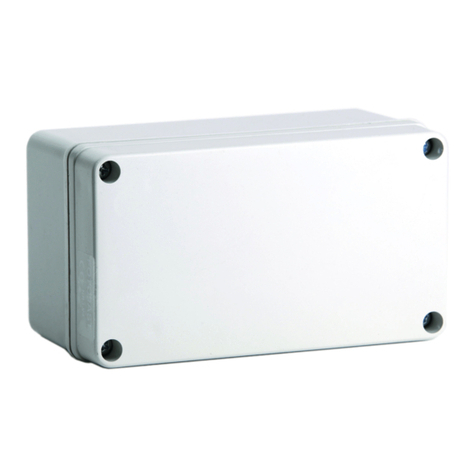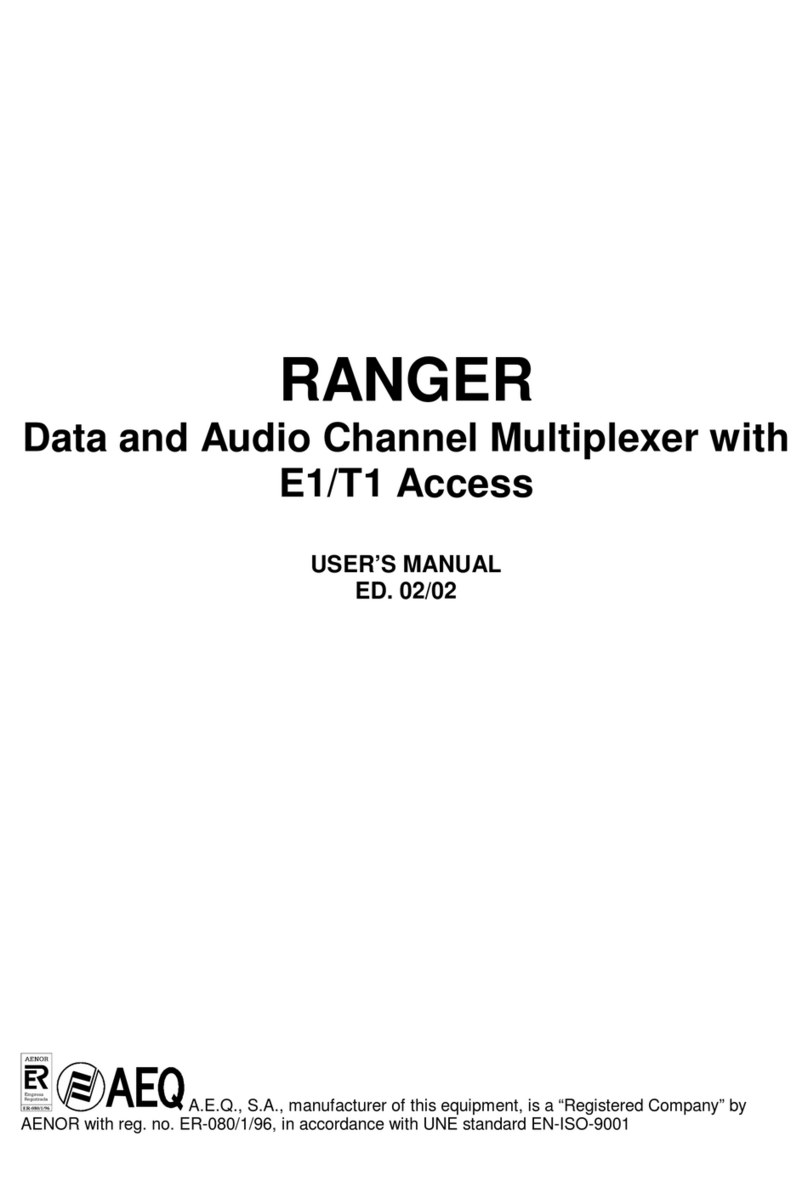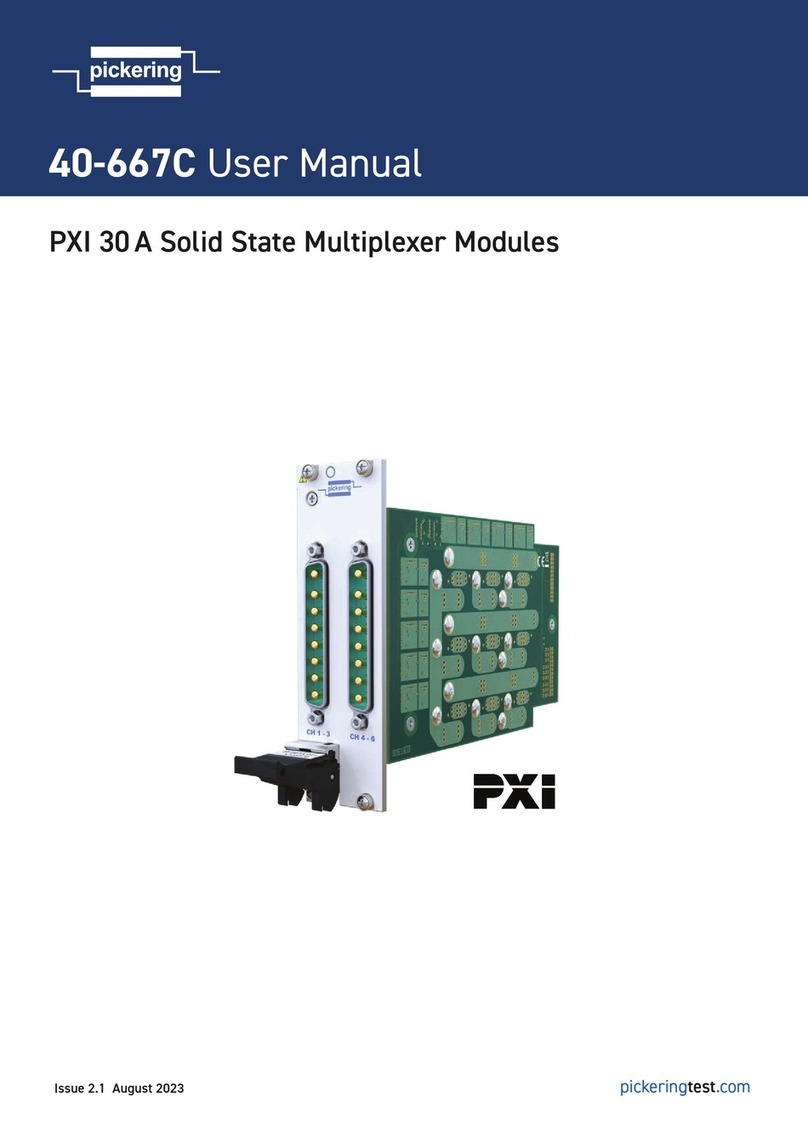Cronyx FMUX/16E1 User manual

© 2005 Cronyx
Multiplexer
FMUX / 16E1
16 E1 Channels
Installation and Operation Manual
Document Version: 2.2E / 15.06.2005

FMUX/16E1 Multiplexer
© 2005 Cronyx
2
Safety Precautions
An exclamation point enclosed in a triangle warns the user about important
operations and maintenance instructions for the device.
It is mandatory to observe the existing safety rules during installation, operation,
and maintenance of the device. Installation, maintenance, and repair operations must
be performed only by qualied and certied personnel. Installation, maintenance,
and repair operations may not be performed by the operator or the user.
FMUX multiplexer equipment has been tested in the communication hardware
and systems testing center of CNIIS of the Ministry of Communication of Russian
Federation and has been acknowledged to comply the following technical speci-
cations:
• RD 45.100-2000 «Technical requirements for the equipment of ber optic
transmission path of plesiochronous digital hierarchy»
• «Technical requirements for the 2/8 Mbps second order digital multiplex equip-
ments of digital transmission systems», approved by the Ministry of Commu-
nications of the Russian Federation, January 17, 1997
• «Technical requirements for the 2/34 Mbps third order digital multiplex equip-
ments of digital transmission systems», approved by the Ministry of Commu-
nications of the Russian Federation, January 17, 1997
• GOST R ISO 9001-96.
FMUX multiplexer hardware is admitted to be used in the interconnected com-
munication network of the Russian Federation as second and third order digital
multiplex equipment with optical transmission path.
Cronyx reserves the right to make changes to technical characteristics and design of
the device without the prior notification of customers.

FMUX/16E1 Multiplexer
© 2005 Cronyx
3
Contents
Chapter 1. Introduction...................................................5
1.1. Application............................................................................................... 5
1.2. Basic Features of the FMUX Family of Multiplexers ............................. 6
1.3 Ordering Information ................................................................................ 7
1.4. Technical Specications .......................................................................... 8
Optical Transceiver.................................................................................. 8
E1 Port Interface ...................................................................................... 9
E3 Link Interface ..................................................................................... 9
Alarm Port Interface ................................................................................ 9
Console Port Interface ............................................................................. 9
SNMP Port Interface.............................................................................. 10
Diagnostic Modes .................................................................................. 10
Mechanical Characteristics.................................................................... 10
Power Requirements.............................................................................. 10
Environmental Characteristics............................................................... 10
Section 2. Installation....................................................11
2.1. Site Requirements ...................................................................................11
2.2. Optical Link Power Budget Precautions.................................................11
2.3. Features of WDM Single Fiber Optical Transceivers.............................11
2.4. Delivered Items.......................................................................................11
2.5. Connections............................................................................................ 12
Power Connection.................................................................................. 12
Ground Terminal.................................................................................... 12
E1 Ports Connectors .............................................................................. 13
TX and RX Optical Link Connectors .................................................... 13
TX and RX E3 Link Connectors ........................................................... 13
SNMP Port Connectors.......................................................................... 14
Console Port Connector......................................................................... 14
Alarm Port Connector............................................................................ 15
Chapter 3. Operation.................................................... 16
3.1. Front Panel Indicators ............................................................................ 16
3.2. Alarm Conditions ................................................................................... 18

FMUX/16E1 Multiplexer
© 2005 Cronyx
4
3.3. Device Response to Special Conditions................................................. 19
3.4. Loopbacks .............................................................................................. 20
Local Link Loopback............................................................................. 20
Remote Link Loopback ......................................................................... 20
Port Loopback........................................................................................ 21
3.5. Built-in BER Tester................................................................................ 22
Link Testing: Remote Link Loopback Enabled..................................... 23
Link Testing: Two BER Testers Enabled Against Each Other............... 23
Section 4. Control From the Console ......................... 24
4.1. Upper Level Menu ................................................................................. 24
4.2. Menu Structure....................................................................................... 26
4.3. «Link statistics» Menu........................................................................... 27
4.4. «Port statistics» Menu............................................................................ 28
4.5. «Event counters» Command .................................................................. 29
4.6. «Loopback» Menu ................................................................................. 30
«Ports 0-7 loop» and «Ports 8-15 loop» Menus .................................... 31
4.7. «Test» Menu........................................................................................... 32
4.8. «Congure» Menu ................................................................................. 33
«Ports 0-7 usage» and «Ports 8-15 usage» Menus ................................ 33
«SNMP» Menu ...................................................................................... 34
«Sensor input» Command...................................................................... 35
«Factory settings» Command ................................................................ 35
«Save parameters» Command ............................................................... 35
«Restore parameters» Command........................................................... 35
4.9. «Login to remote FMUX» Command.................................................... 36
4.10. «Reset» Command ............................................................................... 36
Section 5. SNMP-based Management......................... 37
5.1. SNMP Parameters Setting...................................................................... 37
5.2. Management Information Blocks (MIBs).............................................. 38

FMUX/16E1 Multiplexer
© 2005 Cronyx
5
Chapter 1. Introduction
1.1. Application
FMUX/16E1 is a multiplexer that allows the transmission of sixteen E1 channels via
ber optic or E3 link.
Note. Hereinaer the term «E1» is used for a designation of the data link having the interface
at nominal bit rate of 2048 kbps in conformity with the ITU-T Recommendation G.703,
and operated in both framed mode in conformity with the ITU-T Recommendation G.704
(or with the IKM-30) and unframed (transparent) mode.
The gure below shows the product application diagram:
Each E1 channel is transmitted independently so that the clock frequency of each chan-
nel should not depend on other channels clock frequencies.

FMUX/16E1 Multiplexer
© 2005 Cronyx
6
1.2. Basic Features of the FMUX Family of Multiplexers
• Transmission of four, eight or sixteen E1 channels via ber optic link (16-channel
version may be ordered with E3 link option)
• Single mode or multimode ber
• Distance up to 150 km
• Single ber transmission option
• Models with additional Ethernet 10/100Base-T or V.35/RS-530/RS-449/RS-232
ports
• Model with Ethernet 10/100Base-T port operates in remote bridge mode and supports
VLAN protocol
• Compliance with ITU-T G.703, G.704, G.742, G.751, G.823, G.955, O.151 and IEEE
802.3 standards
• Local and remote loopbacks
• Integrated BER tester
• Console RS-232 port
• SNMP-based management option (via dedicated Ethernet 10Base-T port)
• Alarm interface («dry contacts» relay)
• Stand-alone or 1U 19-inch rack-mount version
• AC or DC power.
The device operation may be controlled from the console (ASCII terminal connected
to the RS-232 control port). The device may be equipped with the dedicated Ethernet
10Base-T port to support SNMP-based management.
The multiplexer’s front panel indicators display the channels availability, loopbacks
enable and testing modes.
The built-in BER tester allows the error level measurement in the E1 link. The mea-
surements are performed on the xed or pseudorandom code subject to the ITU-T
Recommendation O.151 guidelines (supported length of sequence is 223-1=8388607
bits).
There is a capability of remote login to control the remote device operation from the
console port of the local device (this mode may be useful if there is no service person-
nel on the remote end of the link). Commands are transmitted to the remote device via
additional monitoring channel.
The device is equipped with an emergency alarm relay. The state of the relay on the lo-
cal device depends on fault conditions detected and may be controlled from the remote
device. The relay operates in «dry contacts» mode and may be used for prompt main-
tenance (according to the ITU-T Recommendations G.742 and G.751).
The rmware of the device may be updated by user. The instructions for updating the
rmware may be found at the www.cronyx.ru web site.

FMUX/16E1 Multiplexer
© 2005 Cronyx
7
1.3 Ordering Information
Electric power:
-AC — ~176...264VAC
-DC — =36...72VDC
Ports:
/16E1 — 16 E1 ports
Connector:
/FC — FC type, optical
/ST — ST type, optical
/BNC — BNC type, coaxial
(for E3 module)
Line module:
-TM13 — MM, LED, 1310 nm;
up to 2 - 5 km
-TS13 — SM, FP LD, 1310 nm;
up to 40 - 80 km
-TS15 — SM, DFB LD, 1550 nm;
up to 80 - 150 km
-TW13 — SM, FP LD, 1310 nm;
single fiber; up to 40 -
60 km
-TW15 — SM, DFB LD, 1550 nm;
single fiber; up to 40 -
60 km
-E3 — E3 interface
_____
SM — single mode fiber
MM — multimode fiber
SNMP-based management
option: dedicated Ethernet
10Base-T port

FMUX/16E1 Multiplexer
© 2005 Cronyx
8
1.4. Technical Specications
Optical Transceiver
Optical Module
TM13 TS13 TS15 TW13 TW15
Fiber Type Multimode,
50/125
Single Mode,
9/125
Single Mode,
9/125
Single Mode,
9/125
Single Mode,
9/125
No. of Fibers Two Two Two One One
Minimum Fiber
Optic Cable Pow-
er Budget
13 dB 29 dB 29 dB 26 dB 26 dB
Fiber Optic Cable
Minimum Length
Limitation
No No No No No
M a x i m u m F i -
ber Optic Cable
Length
2 - 5 km 40 - 80 km 80 - 150 km 40 - 60 km 40 - 60 km
Note
Uses WDM,
requires the
TW15 opti-
cal module at
the opposite
end of ber
Uses WDM,
requires the
TW15 opti-
cal module at
the opposite
end of ber
Transmitter
Transmitter Type LED FP LD DFB LD FP LD DFB LD
Wavelength 1310 nm 1310 nm 1550 nm 1310 nm 1550 nm
Optical Output
Power -19 dBm -5 dBm -5 dBm -8 dBm -8 dBm
Spectral Width 200 nm 3 nm 1 nm 3 nm 1 nm
Receiver
Maximum Input
Optical Power -14 dBm -3 dBm -3 dBm -3 dBm -3 dBm
Receiver Sensi-
tivity -32 dBm -34 dBm -34 dBm -34 dBm -34 dBm

FMUX/16E1 Multiplexer
© 2005 Cronyx
9
E1 Port Interface
Nominal bit rate ............................................. 2048 kbps
Line code........................................................ HDB3
Framing.......................................................... Transparent stream transmission either
with framing (Framed G.704) or with-
out framing (Unframed G.703)
Error detection ............................................... Code violation
Line impedance.............................................. 120 Ohm symmetric (twisted pair)
Receiver signal level...................................... From 0 up to –12 dB
Jitter attenuation............................................. In transmit path
Overvoltage protection................................... TVS
Overcurrent protection................................... Fuse
Connector type............................................... RJ-48 (8-wire socket)
E3 Link Interface
(for the «-E3/BNC» version)
Nominal bit rate ............................................. 34.768 Mbps
Line code........................................................ HDB3
Error detection ............................................... Code violation
Line impedance.............................................. 75 Ohm (coax cable)
Receive signal attenuation range ................... From 0 to –15 dB (up to 440 m)
Overvoltage protection................................... TVS
Overcurrent protection................................... Fuse
Connector type............................................... BNC
Alarm Port Interface
Connector type............................................... DB-9 (female)
Relay contact current ..................................... Up to 600 mA
Relay contact voltage..................................... Up to 110 VDC or up to 125 VAC
Console Port Interface
Interface type, connector type ....................... RS-232 DCE, DB-9 (female)

FMUX/16E1 Multiplexer
© 2005 Cronyx
10
Data transfer mode......................................... Asynchronous, 9 600 baud, 8 bits per
character, 1 stop bit, no parity
Modem signals............................................... DTR, DSR, CTS, RTS, CD
SNMP Port Interface
(for the «-SNMP» version)
Interface type ................................................. Ethernet 10Base-T
Connector type............................................... RJ-45 (8-wire socket)
Diagnostic Modes
Loopbacks...................................................... Local, remote
Error rate measurement.................................. Built-in BER tester
Control ........................................................... Via the console port, from a remote
device, via the SNMP port (for the
«-SNMP» version)
Mechanical Characteristics
Construction................................................... 1U rack mount for 19-inch cabinet
Dimensions .................................................... 444 mm x 262 mm x 44 mm
Weight ............................................................ 3.4 kg
Power Requirements
AC supply voltage.......................................... 176–264 VAC, 50 Hz (for the «-AC»
version)
DC supply voltage.......................................... 36–72 VDC (for the «-DC» version)
Max. power consumption............................... 20 VA
Environmental Characteristics
Temperature ................................................... 0 to 50 °C
Relative humidity........................................... Up to 80%, non-condensing

FMUX/16E1 Multiplexer
© 2005 Cronyx
11
Section 2. Installation
2.1. Site Requirements
e device should be grounded properly before powering on. Grounding screw located
on the front panel of the device.
Allow at least 10 cm clearance at the front of the device for cable connections.
e ambient operating temperature should be 0 to 50 °C, at a relative humidity of up to
80%, non-condensing.
2.2. Optical Link Power Budget Precautions
All components of ber optic link are subjected to ageing (cable’s attenuation tends to
raise and parameters of optical transceiver tend to degrade with time).
For the reliable operation it is recommended to ensure that optical power budget of the
link be initially extended by 10 to 25 % to compensate the ageing effects.
2.3. Features of WDM Single Fiber Optical Transceivers
Single ber optical transceivers TW13 and TW15 apply the WDM technology to trans-
mit signals in the opposite directions using different wavelengths of laser light. Thus
the use of the TW13 transceiver at one end of the ber assumes the TW15 be used at
the opposite end of the ber.
Requirements to optical cables and splices for single ber WDM transceivers are the
same as for two ber ones.
2.4. Delivered Items
FMUX unit of a version as ordered ................................................1 piece
Bracket for mounting the FMUX unit in a 19-inch cabinet............2 pieces
Self-adhesive foot for the FMUX unit............................................4 pieces
Power cable (for the «-AC» version) ..............................................1 piece

FMUX/16E1 Multiplexer
© 2005 Cronyx
12
FMUX unit grounding screw..........................................................1 piece
3-screw removable terminal block (for the «-DC» version)..........1 piece
This Installation and Operating manual..........................................1 piece.
2.5. Connections
All connectors are located on the front panel of the device.
LERR LOS
RERR LOW
TST
PWR
SNMP CONSOLE ALARM
TX RX
4 5 6 7 12 13 14 15
Alarm Port
Console Port
E1 Ports
Power
GND
Link RX
Link TX
SNMP Port
0 1 2 3 8 9 10 11
Power Connection
AC power (for the «-AC» version) is supplied to the device through a standard AC power
connector (IEC 320 C14). e power cable is supplied with the device.
e DC power connector (for the «-DC» version) is shown below (view from the front
of the device):
e 3-screw removable terminal block is supplied with the device.
Ground Terminal
An M4 grounding screw is located on front panel of the device.
Before powering the device on and before connecting other cables, device
must be properly grounded.

FMUX/16E1 Multiplexer
© 2005 Cronyx
13
E1 Ports Connectors
An RJ-48 socket is provided for the E1 ports cables connection:
TX and RX Optical Link Connectors
Standard FC or ST type connectors are used to connect the ber optic link depending on
the ordering code. Use optical cables to interconnect the TX connector of local device
to the RX connector of the remote one, and vice versa. (In single ber versions of the
device the only optical connector is mounted at the TX position.)
Additional care should be taken by handling optical cables and connec-
tors:
• Do not allow sharp-edged bending and twisting of optical
cables.
• Do not apply excessive force by connecting optical cable to
avoid damage of the optical connector.
• It is recommended to clean out optical connectors by blowing
with pressurized ltered air before connecting optical cables.
TX and RX E3 Link Connectors
Standard BNC connectors are used to connect cables by interconnecting devices ordered
with the «-E3/BNC» line module/connector option. Use coax cables to interconnect the
TX connector of local device to the RX connector of the remote one, and vice versa.

FMUX/16E1 Multiplexer
© 2005 Cronyx
14
SNMP Port Connectors
An RJ-45 sockets are provided for connection cables to Ethernet 10Base-T port for
SNMP-based management:
Use straight cable to connect the device to Ethernet hub.
Console Port Connector
Device operation may be controlled from the ASCII terminal (the console). DB-9 (fe-
male) connector is used to connect the console. Console port has a standard RS-232
DCE interface and should be used in asynchronous operating mode, 9600 bps rate, 8 bit
per character, 1 stop bit, no parity. Use straight cable to connect to the computer COM
port.
An RTS signal (for ow control) from the console terminal is required for
proper operation.
e following cable wiring schemes are recommended:
Cable without modem control
GND 5
TXD 3
RXD 2
RTS 7
CTS 8
DTR 4
CD 1
GND
TXD
RXD
RTS
CTS
DTR
DSR
CD
GND 5
TXD 3
RXD 2
RTS 7
CTS 8
DTR 4
DSR 6
CD 1
GND
TXD
RXD
RTS
CTS
DTR
DSR
CD
Cable with modem control
Use straight cable to connect to the COM port of the computer.

FMUX/16E1 Multiplexer
© 2005 Cronyx
15
Alarm Port Connector
A DB-9 (female) connector is used for alarm port connection:
Pin allocation:
5 – open in no alarm state, closed to middle relay contact (9)
on alarm
4 – closed to middle relay contact (9) in no alarm state, open
on alarm
3 – to external input sensor
9 – middle relay contact
7, 8 – GND
1, 2, 6 – reserved (must be leaved unconnected)
Alarm relay
(shown in no alarm state)
External input sensor
54321
87
96
+5 VDC
Internal device circuits
Pin layout shown from outside of the device
e external input sensor connected to the modem must be isolated from other
electrical circuits. Failure to comply with this requirement may lead to modem
breakdown.

FMUX/16E1 Multiplexer
© 2005 Cronyx
16
Chapter 3. Operation
3.1. Front Panel Indicators
e indicators displaying the device status are located on the front panel. e list of
indicators and their purpose are shown in the table.
LERR LOS
RERR LOW
TST
PWR
SNMP CONSOLE ALARM
TX RX
1 2 43 3
567 8 9 10
4 5 6 7 12 13 14 15
0 1 2 3 8 9 10 11
4
e reference numbers on the gure correspond to the numbers in the table.
No. Indicator Color Function
1 LERR Red Link errors indication
On or blinking: High link input signal error
rate
On: Test pattern is being received, local link
loopback enabled
On or blinking: BER tester errors, test mode
enabled (TST indicator is on)
2 LOS Red On: link input carrier is lost
3 PORT LOS Red E1 port errors indication
Blinking: E1 port HDB3 coding errors
On: E1 port input carrier is lost
On: AIS is being received at E1 port input
4 PORT STATE Green E1 port state indication
On: Normal operation
Off: Port unused
Blinking: Port loopback enabled
5 PWR Green On: Unit powered
Off: Unit not powered

FMUX/16E1 Multiplexer
© 2005 Cronyx
17
No. Indicator Color Function
6 TST Red Test mode indication
On: BER tester enabled towards the link
Blinking: Local link loopback enabled
Blinking in double ashes: Remote link loop-
back enabled
7 RERR Red Remote device errors indication (link input
carrier is present)
On or blinking: Input carrier or frame syn-
chronization is lost at the remote end of link
8 LOW Red Reserved
9 SNMP EACT Green SNMP port Ethernet activity indication
Blinking: Ethernet data transfer in progress
10 SNMP ELINK Green On: Ethernet 10Base-T cable is connected to
the SNMP port
During the normal operation, the indicators must be in the following states:
Indicator Color Light State at Normal Operating Condition
PWR Green On
TST Red Off
LOS Red Off
LOW Red Off
LERR Red Off
RERR Red Off
PORT LOS Red Off
PORT STATE Green On: Port is in use
SNMP EACT Green Blinking: Ethernet 10Base-T data transmission via the
SNMP port is in progress
SNMP ELINK Green On: Ethernet 10Base-T cable is connected to
the SNMP port

FMUX/16E1 Multiplexer
© 2005 Cronyx
18
3.2. Alarm Conditions
e device is equipped with an alarm interface.
e alarm relay is used for turning on an external alarm unit (e.g. bell, buzzer, control
panel indicator, etc.) during an emergency situation.
e alarm relay is used in «dry contacts» mode (that is, its contacts are isolated from any
electrical circuits of the device).
Alarm conditions are as follows:
• Power failure
• Loss of signal or there is no frame synchronization in the link.
• Loss of signal at least at one of E1 ports congured as «In use»
• Alarm signal generated by the external input sensor at the remote device is being
received.
e external input sensor has two modes of generation of the alarm signal to be trans-
mitted to the remote device: closing-sensitive (set by default) and opening-sensitive.
e mode may be changed from the console (see para. «Sensor input» Command at the
chapter 4.7 «Congure» Menu below).
If the device is installed in a non-serviced room, the input sensor contacts may be driven,
for example, by remote climate sensors, door opening sensors, etc.
For more details please see the schematics at para. Alarm Port Connector of the chapter
2.5. Connections above.

FMUX/16E1 Multiplexer
© 2005 Cronyx
19
3.3. Device Response to Special Conditions
Local Device Remote Device
Condition Indicators
and Relay
AIS Output
to E1 Ports
Indicators
and Relay
AIS Output
to E1 Ports
Power failure All indicators: Off
Relay: Alarm
LOS: On
Relay: Alarm
To all ports
Loss of input signal
from link
LOS: On
Relay: Alarm
To all ports RERR: On
High link input signal
error rate
LERR: On
Relay: Alarm
To all ports RERR: On
Е1 port N congured
as «Unused»
PORT N STATE:
Off
Loss of E1 port N
input signal (port is
«In use»)
PORT N LOS:
On
Relay: Alarm
To port N
Loss of E1 port N
input signal (port is
«Unused»)
PORT N STATE:
Off
To port N
AIS is being received
at the E1 port N
PORT N LOS:
On
To port N
Local link loopback
is enabled
TST: Blinking To all ports
Remote link loop-
back is enabled
TST: Blinking in
double ashes
TST: Blinking To all ports
E1 port N loopback
is enabled
PORT N STATE:
Blinking
To port N

FMUX/16E1 Multiplexer
© 2005 Cronyx
20
3.4. Loopbacks
Local Link Loopback
Local Mux
Link Loopback: Enabled,
TST Indicator: Blinking
Remote Mux
AIS AIS
AIS AIS
AIS AIS
E1 Ports
Link
E1 Ports
Remote Link Loopback
AIS AIS
AIS AIS
AIS AIS
Link
E1 Ports E1 Ports
Local Mux
Remote Link Loopback: Requested
TST Indicator: Blinking in Double
Flashes
Remote Mux
Link Loopback: Enabled by
Remote Request
TST Indicator: Blinking
Table of contents
Other Cronyx Multiplexer manuals
Popular Multiplexer manuals by other brands
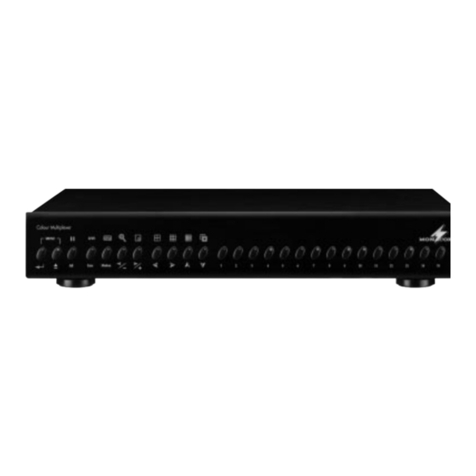
Monacor
Monacor TVMP-2216COL instruction manual

BRUEL & KJAER
BRUEL & KJAER 1056 user manual
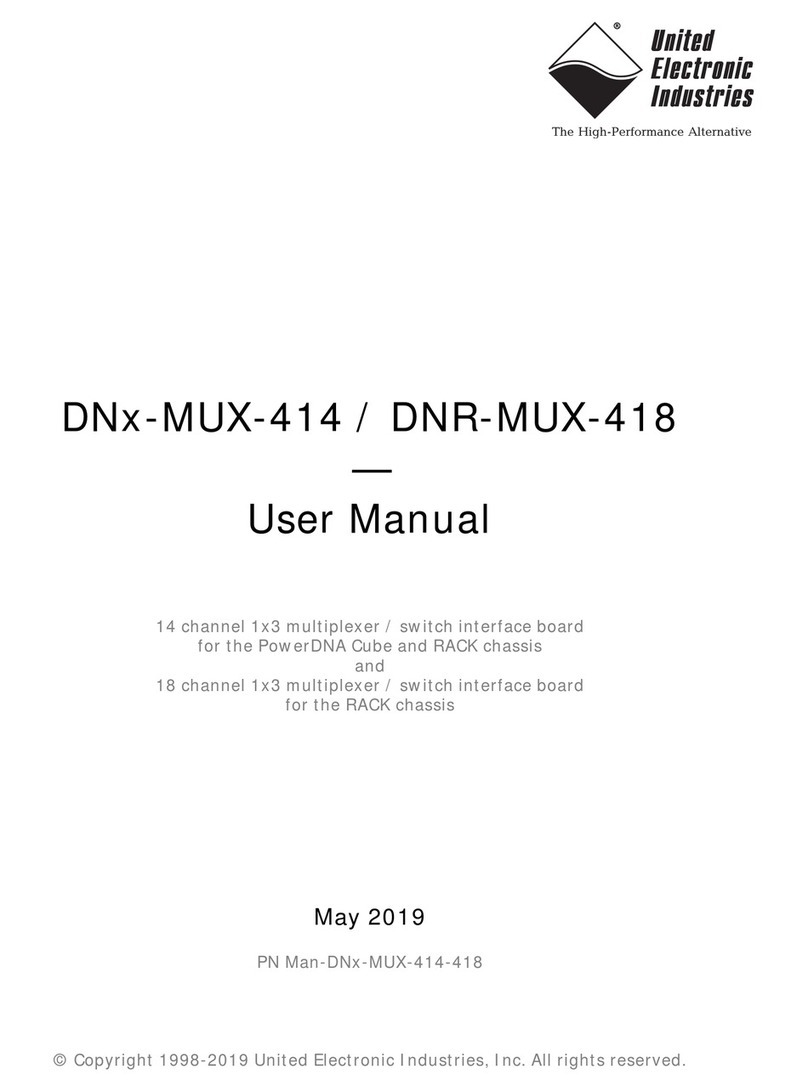
United Electronic Industries
United Electronic Industries DN-MUX-414 Series user manual
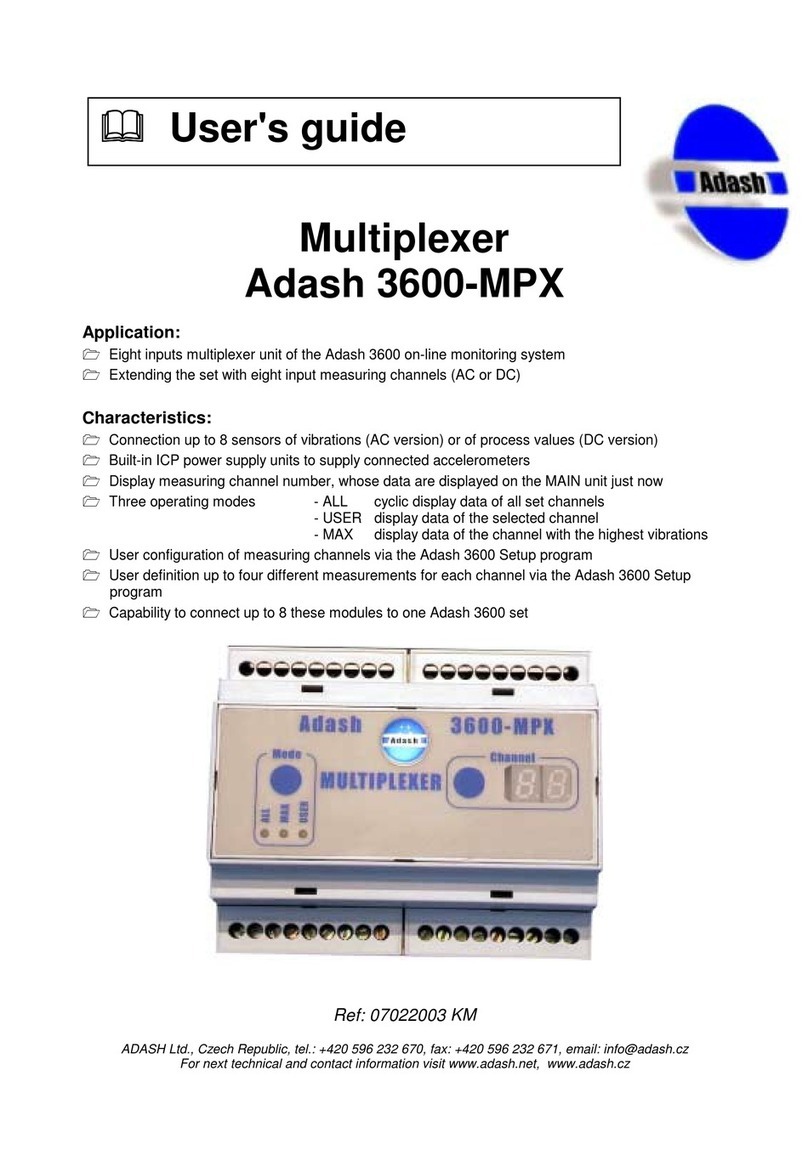
Adash
Adash 3600-MPX user guide

Viessmann
Viessmann 52292 Operation manual

Ganz
Ganz ZS-SX Series Installation and operating instructions
